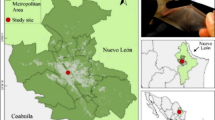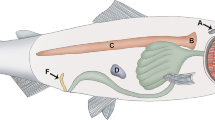Abstract
The karyotype of the black-winged kite (Elanus caeruleus), a small diurnal raptor living in Africa, Asia and southern Europe, was studied with classical (G-, C-, R-banding, and Ag-NOR staining) and molecular cytogenetic methods, including primed in-situ labelling (PRINS) and fluorescence in-situ hybridization (FISH) with telomeric (TTAGGG) and centromeric DNA repeats. The study revealed that the genome size, measured by flow cytometry (3.1 pg), is in the normal avian range. However, the black-winged kite karyotype is particularly unusual among birds in having a moderate diploid number of 68 chromosomes, and containing only one pair of dot-shaped microchromosomes. Moreover, the macrochromosomes are medium-sized, with the Z and W gonosomes being clearly the largest in the set. C-banding shows that constitutive heterochromatin is located at the centromeric regions of all chromosomes, and that two pairs of small acrocentrics and the pair of microchromosomes are almost entirely heterochromatic and G-band negative. The distribution pattern of a centromeric repeated DNA sequence, as demonstrated by PRINS, follows that of C-heterochromatin. The localization of telomeric sequences by FISH and PRINS reveals many strong telomeric signals but no extratelomeric signal was observed. The atypical organization of the karyotype of the black-winged kite is considered in the context of the modes of karyotypic evolution in birds.
Similar content being viewed by others
References
Altschul SF, Gish W, Miller W, Myers EW, Lipman DJ (1990) Basic local alignment search tool. J Mol Biol 215: 403-410.
Ansari HA, Kaul DP (1986) Cytotaxonomic studies in the order Falconiformes (Aves). Zool Scr 15: 351-356.
Bed'Hom B (1999) Etude des Caryotypes Atypiques des Accipitridae (Aves, Falconiformes) par Cytogènètique Classique et Mole¤ culaire, et Modèlisation de leur Evolution. PhD thesis, University of Tours.
Bed'Hom B (2000) Evolution of karyotype organisation in Accipitridae: a translocation model. In: Sankoff D, Nadeau JH, eds. Comparative Genomics. Dordrecht: Kluwer Academic Publishers, pp 347-356.
Bed'Hom B, Darre R, Fillon V (1998) Chromosome banding studies in the Bateleur (Terathopius ecaudatus: Aves, Accipitridae). Chromosome Res 6: 437-440.
Brown L, Amadon D (1968) Eagles, Hawks and Falcons of the World. London: Country Life Books.
Chen ZQ, Lin CC, Hodgetts RB (1989) Cloning and characterization of a tandemly repeated DNA sequence in the crane family (Gruidae). Genome 32: 646-654.
Christidis L (1990) Animal cytogenetics, 4: Chordata 3 B. Aves. Berlin, Stuttgart: Gebrüder Borntraeger.
Coullin P, Andreo B, Charlieu JP, Candelier JJ, Pellestor F (1997) Primed in situ (PRINS) labelling with Alu and satellite primers for rapid characterization of human chromosomes in hybrid cell lines. Chromosome Res 5: 307-312.
De Boer LEM(1976) The somatic chromosome complements of 16 species of Falconiformes (Aves) and the karyological relationships of the order. Genetica 46: 77-113.
De Boer LEM, Sinoo RP (1984) A karyological study of Accipitridae (Aves: Falconiformes), with karyotypic description of 16 species new to cytology. Genetica 65: 89-107.
De Vita R, Cavallo D, Eleuteri P, Dell'Omo G(1994) Evaluation of interspecific DNA content variations and sex identification in Falconiformes and Strigiformes by flow cytometric analysis. Cytometry 16: 346-350.
Goodpasture C, Bloom SE (1975) Visualization of nucleolar organizer in mammalian chromosomes using silver staining. Chromosoma 53: 37-50.
Harris T, Walters C (1982) Chromosomal sexing of the black-shouldered kite (Elanus caeruleus) (Aves: Accipitridae). Genetica 60: 19-20.
Holdaway RN (1994) An exploratory phylogenetic analysis of the genera of the Accipitridae, with notes on the biogeography of the family. In: Meyburg BU, Chancellor ED, eds. Raptor Conservation Today. London & Berlin: WWGBP / The Pica Press, pp 601-649.
Keyser C, Montagnon D, Schlee M, Ludes B, Pfitzinger H, Mangin P (1996) First isolation of tandemly repeated DNA sequences in New World vultures and phylogenetic implications. Genome 39: 31-39.
Kohler CD, Schaadt CP, Vekemans MJJ (1989) Chromosome banding studies of the osprey Pandion haliaetus (Aves, Falconiformes). Genome 32: 1037-1040.
Ladjali K, Tixier-Boichard M, Cribiu EP (1995) High-resolution chromosome preparations for G-and R-banding in Gallus domesticus. J Hered 86: 136-139.
Longmire LJ, Lewis AK, Brown NC et al. (1988) Isolation and characterization of a highly polymorphic centromeric tandem repeat in the family Falconidae. Genomics 2: 14-24.
Madsen CS, de Kloet DH, Brooks JE, de Kloet SR (1992) Highly repeated DNA sequences in birds: the structure and evolution of an abundant, tandemly repeated 190-bp fragment in parrots. Genomics 14: 462-473.
Madsen CS, Brooks JE, de Kloet E, de Kloet SR (1994) Sequence conservation of an avian centromeric repeated DNA component. Genome 37: 351-355.
Meyne J, Ratliff RL, Moyzis RK (1989) Conservation of the human telomere sequence (TTAGGG)n among Vertebrates. Proc Natl Acad Sci USA 86: 7049-7053.
Meyne J, Baker RJ, Hobart HH et al. (1990) Distribution of non-telomeric sites of the (TTAGGG)n telomeric sequence in Vertebrate chromosomes. Chromosoma 99: 3-10.
Nanda I, Schmid M(1994) Localization of the telomeric (TTAGGG)n sequence in chicken (Gallus domesticus) chromosomes. Cytogenet Cell Genet 65: 190-193.
Nanda I, Schrama D, Feichtinger W, Haaf T, Schartl M, Schmid M(2002) Distribution of telomeric (TTAGGG)n sequences in avian chromosomes. Chromosoma 111: 215-227.
Padilla JA, Martinez-Trancon M, Rabasco A, Fernandez-Garcia JL (1999) The karyotype of the Iberian imperial eagle (Aquila adalberti) analyzed by classical and DNA replication banding. Cytogenet Cell Genet 84: 61-66.
Saifitdinova AF, Derjusheva SE, Malykh AG, Zhurov VG, Andreeva TF, Gaginskaya ER (2001) Centromeric tandem repeat from the chaffinch genome: isolation and molecular characterization. Genome 44: 96-103.
Schmid M, Enderle E, Schindler D, Schempp W(1989) Chromosome banding and DNA replication patterns in bird karyotypes. Cytogenet Cell Genet 52: 139-146.
Seabright M(1971) A rapid banding technique for human chromosomes. Lancet 2: 971-972.
Shetty S, Griffin DK, Marshall Graves JA (1999) Comparative painting reveals strong chromosome homology over 80 million years of bird evolution. Chromosome Res 7: 289-295.
Sibley CG, Ahlquist JE (1990) Phylogeny and Classiccation of Birds: a Study in Molecular Evolution. New Haven & London: Yale University Press.
Solovei IV, Gaginskaia ER, Hutchison N, Macgregor HC (1993) Avian sex chromosomes in the lampbrush form: the ZW lampbrush bivalent from six species of birds. Chromosome Res 1: 153-166.
Sumner AT (1972) A simple technique for demonstrating centromeric heterochromatin. Exp Cell Res 83: 438-442.
Tegelström H, Ryttman H (1981) Chromosomes in birds (Aves): evolutionary implications of macro-and microchromosomes numbers and lengths. Hereditas 94: 225-233.
Venturini G, D'Ambrogi R, Capanna E (1986) Size and structure of the bird genome. I. DNA content of 48 species of Neognathae. Comp Biochem Physiol B 85: 61-65.
Vindelov LL (1977) Flow microfluorometric analysis of nuclear DNA in cells from solid tumors and cell suspensions. A new method for rapid isolation and staining of nuclei. Virchows Arch B Cell Pathol 24: 227-242.
Vindelov LL, Christensen IJ, Nissen NI (1983) Standardization of high-resolution flow cytometric DNA analysis by the simultaneous use of chicken and trout red blood cells as internal reference standards. Cytometry 3: 328-331.
Author information
Authors and Affiliations
Rights and permissions
About this article
Cite this article
Bed'Hom, B., Coullin, P., Guillier-Gencik, Z. et al. Characterization of the atypical karyotype of the black-winged kite Elanus caeruleus (Falconiformes: Accipitridae) by means of classical and molecular cytogenetic techniques. Chromosome Res 11, 335–343 (2003). https://doi.org/10.1023/A:1024091923939
Issue Date:
DOI: https://doi.org/10.1023/A:1024091923939




